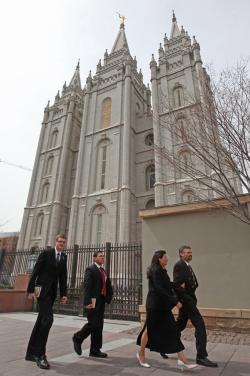Mormon Church leaders apologized Tuesday after the parents of the late Jewish rights advocate and Nazi hunter Simon Wiesenthal were baptized by proxy in late January. Meanwhile, Holocaust survivor and Nobel laureate Elie Wiesel said that Mitt Romney “should speak to his own church and say they should stop.” Is there any straightforward way to get your name on the Mormons’ “Do Not Baptize” list?
No. To avoid unwanted baptisms, the Church of Jesus Christ of Latter-day Saints largely relies on the discretion of its members. Church policy advises that members should not request baptisms for the dead except for their own ancestors. Since this policy is difficult to enforce, some Mormons do baptize more widely. To the extent that a “Do Not Baptize” list exists, it includes only the names of Holocaust victims. The church says it learned that such baptisms were occurring in 1991 and formally ordered a stop to them; when it received complaints from an organization of Holocaust survivors in 1995, it re-emphasized the directive and removed hundreds of thousands of names from genealogical records. Even so, members have disregarded the order again and again. A centralized database of those who have been baptized exists online, although only church members can obtain a login. Officials insist that the church has done its best to monitor these records so as to keep the names of Holocaust victims from being submitted, but some do manage to slip through.
Mormons think of baptisms for the dead as a service to others, almost like adding family members’ names to a guest list. According to Mormon doctrine, dead people who are baptized by proxy don’t automatically join the church. Instead, they have the right to accept or reject the ordinance in the afterlife, and thus the chance to ascend to the highest levels in the afterlife, depending on what they decide. Mormons can participate in baptisms beginning at age 12, and the Mormon Explainer remembers being dunked repeatedly in a ceremonial tub on one of the lower levels of the Boston Temple. He wasn’t sure on whose behalf he was being baptized and would rather have been home playing video games.
Doctrines concerning post-mortem baptisms have been controversial throughout the history of mainstream Christianity as well. The Bible refers to people “baptized for the dead,” but interpretations of the phrase vary widely, and it’s unclear whether the practice was ever commonplace. It’s only in the last two decades that the issue has become a frequent source of controversy for the LDS Church. When the Mormon religion was founded by Joseph Smith in the early 19th century, Calvinist ideas (which held that only an elect few were destined to be saved), were losing popularity to Universalist ideas (which held that all people should have the opportunity to be saved). Smith first presented the doctrine of baptisms for the dead in the 1840s, and Mormons responded rapturously. Early church President Wilford Woodruff later recalled of the occasion, “Joseph Smith himself … went into the Mississippi River one Sunday night after a meeting and baptized a hundred. I baptized another hundred. The next man, a few rods from me, baptized another hundred. We were strung up and down the Mississippi, baptizing for our dead.” The baptisms weren’t centrally recorded, as they are today.
Most Christians object to this practice, but others respect its spirit. The Vatican directed its clergy to keep their parish records from Mormon genealogists, in an effort to hinder Mormon baptisms for their dead members, even though Catholics believe that the baptisms have no authority. Some Mormons are fond of remembering how Lutheran bishop of Stockholm Krister Stendahl said that he felt “holy envy” for the doctrine. He reportedly lamented, “We Lutherans do nothing for our dead.”
The Mormon Explainer thanks Richard Bushman of Columbia University and Terryl Givens of the University of Richmond.
